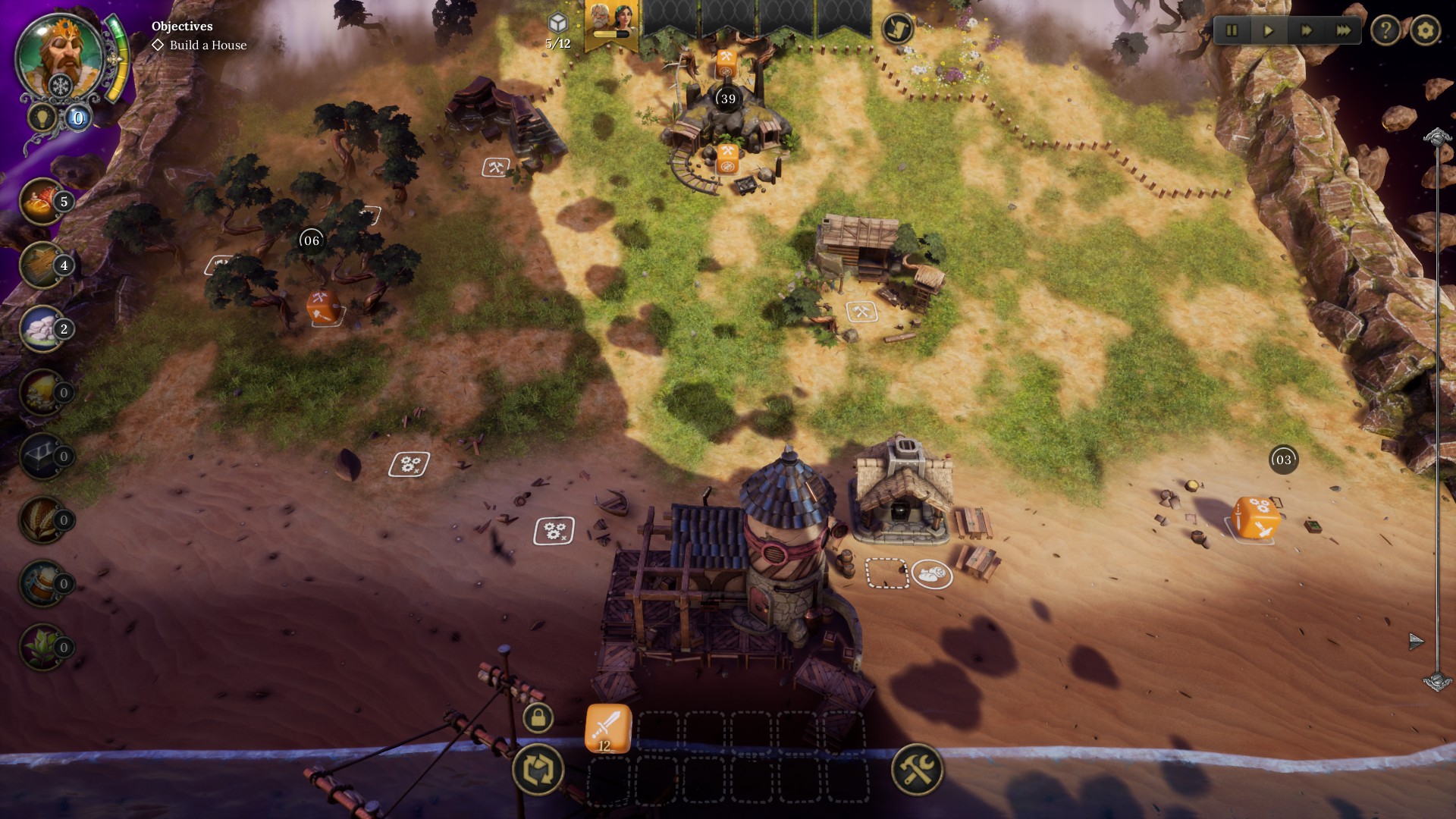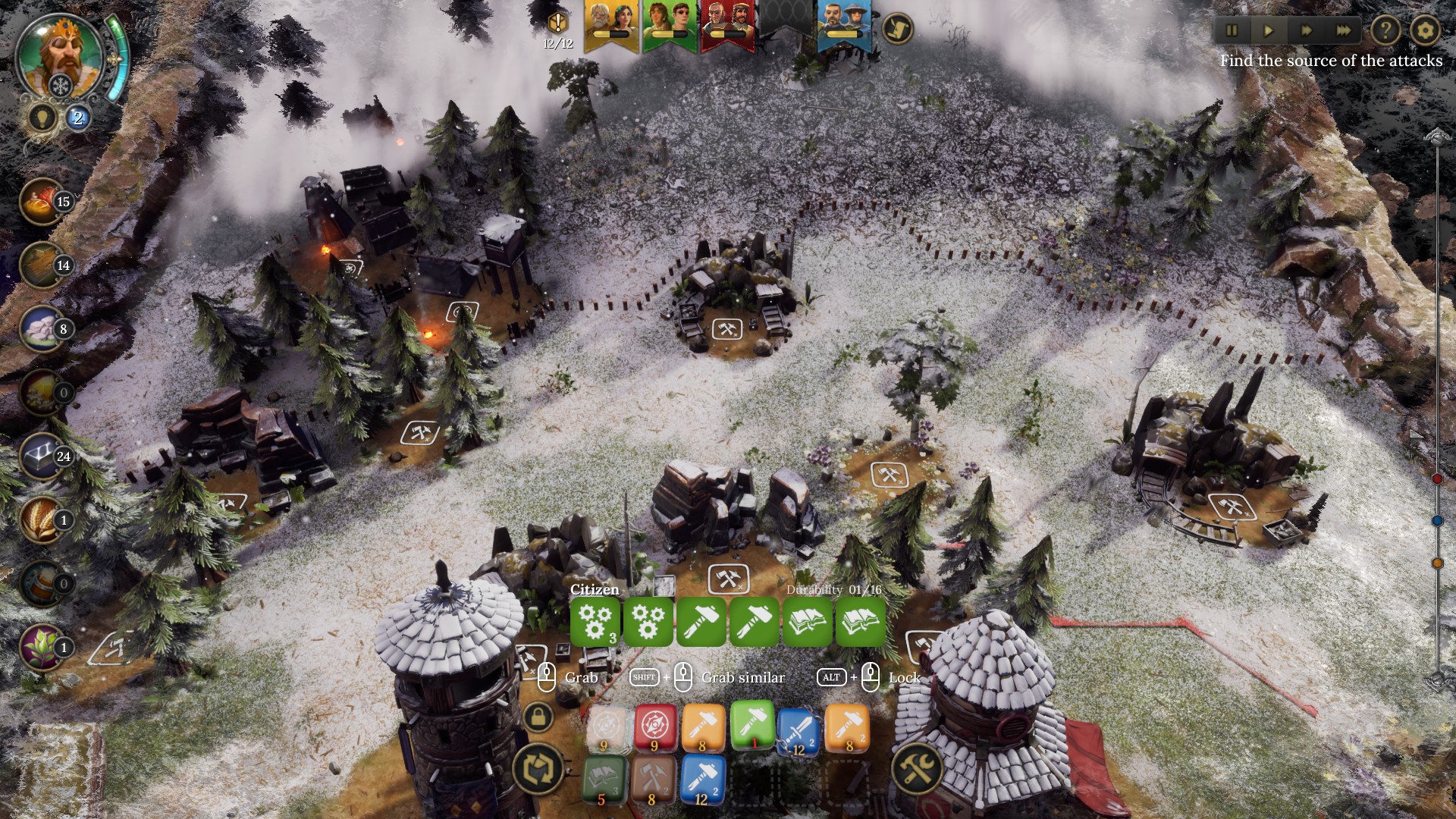Does Dice Legacy make a successful Performance check?
Hands up who here remembers The Settlers, Bluebyte’s mid-90s city building and management game. I wouldn’t be surprised if you don’t recall it all that well, as the last entry was over a decade ago, and it was something of a niche title even in its heyday. Even so, I have fond memories of building my city and cursing the AI citizens for not doing what I wanted them to. Dice Legacy feels a lot like that classic series, but simplified and based on, you guessed it, dice rolls. Being a cross between a real-time city management game, and a dice placement board game, I was very much looking forward to this one.
Once you’ve set up your first game, you’ll find yourself shipwrecked on a mysterious land that’s inexplicably shaped like one of the Halo rings. A tutorial runs you through how to manage Dice Legacy’s core mechanics before tasking you with traveling the map and defeating the raiders that keep harassing your burgeoning settlement. You’ll be introduced to the different worker classes, various buildings, and the main resources that will be available to you.

All your workers are represented by dice of different colours. Orange peasants are good for gathering resources, working in fields, and building structures, whilst blue soldiers can fight and build, but have no capacity for gathering or exploring. You’ll need to use these, alongside monks, merchants, and citizens to get an economy going so that you can continually strengthen your society to take on the forces that regularly attack you. The dice you have are rolled, and you place them on buildings that have the matching face to carry out that structure’s task. A field needs the work side, whilst a workshop wants a book on the dice face. Easy enough to understand, but there’s a catch.
Your dice have that much maligned video game feature: durability. Each time you roll a dice, they lose a point of durability. At first this isn’t a problem, but as your dice get worn out, rerolling because you didn’t get the face you want becomes increasingly risky, as once that durability has run out, the dice is gone forever. You can put the dice in the cookhouse with a food resource to regain some durability, but that’s time being wasted when it could be being used more effectively elsewhere. It’s a feature that makes sense, as it prevents you from just rolling endlessly to get what you want, and adds a bit of pressure due to the real-time nature of Dice Legacy. You often have to make your decisions quickly or find yourself lacking the resources or classes you need.
There’s a further complication too, as each class of dice you have access to comes with a happiness gauge. You need to keep each class content or risk them performing poorly or even harming your operation. Keeping them happy can be as simple as creating more of that class, or building a structure near a hall that belongs to them. However, converting a peasant into a monk may make the monks happy, but it will lower the happiness of the peasants. There’s a constant balancing act to be struck, and sometimes it’s even worth getting rid of an entire class just to avoid repercussions.

To work around this, you can fuse two dice together via the forge or laboratory. Whilst this causes a temporary loss in happiness as you sacrifice two dice, the resultant one can be very powerful, taking the strongest elements of the two sacrificed classes. I found this was the best way to create super powerful soldiers for the end game, and wildly increased the efficiency of my workers. There’s even an option to enhance specific faces of any dice if you wish to.
I loved playing Dice Legacy. This is exactly the sort of game I enjoy, with the pressure of real time combined with the puzzle, choice, and chance elements of the dice. It has that dreaded one-more-turn addictive quality of the Civilization games, but with the real-time factor making it one-more-roll, which turns into a hundred more rolls. Before you realise it, it’s one in the morning and you have to get up for work in a few hours. I just couldn’t help but play more of it. And even once you finish it — a full run through on standard difficulty takes about six hours at a moderate pace — there’s plenty of content to unlock and play again. Different leaders with a variety of special abilities, and different campaigns that add difficult modifiers such as buildings bursting into flame, or an eternal winter that means your workers can freeze, making them useless.
That’s not to say that Dice Legacy is easy though. On standard mode you can win handily enough, even if it can be a bit of a slog as you fight off invaders and try to push forward in the face of dwindling resources — I actually ran out of stone across the whole map on my first run — but anything above that is incredibly challenging. I doubt I’ll even touch extreme mode, let alone finish it.

As much as I loved this game — and I really did — it isn’t without its flaws. The visuals are nice enough, but sometimes they can obscure a building’s requirements for use, which can be a little irritating in a rush, as can the dice colour choices that can be a touch difficult to read sometimes. Seeing a tiny white number that denotes a face’s power on a bright orange dice caused me to squint more than once. The real-time feature could be a real turn off for some people too. I’d have liked to be able to pause and issue orders by dropping dice and resources before resuming the game, though I appreciate that the time pressure is a key feature here. This feature is being added as an option in an update to the game as I understand it, so it’ll be interesting to see how it affects things.
These are minor gripes though, and Dice Legacy is something I’m going to be returning to time and again to try out the various challenge modes, and simply just to play again. As I get older and free time becomes more scarce, a Civilization style game that I can play through in a few hours is very appealing. Strongly recommended!
Dice Legacy is available now on PC.
Comments are closed.